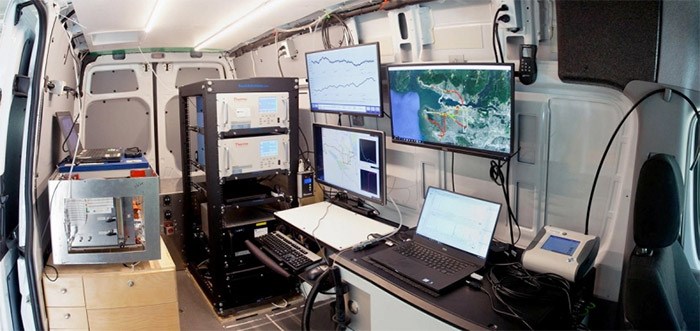 The interior of the Mobile Mass Spectrometry Lab. Photograph Submitted
The interior of the Mobile Mass Spectrometry Lab. Photograph Submitted
A portable mass spectrometer can supply its operator with the equivalent of high-tech canine sniffer, says a Vancouver Island University chemist.
A mass spectrometer can identify molecules in the air and water and be used to detect the presence of narcotics and some diseases, Prof. Erik Krogh said. “These instruments are, in a sense, very advanced, sensitive, electronic noses.”
Now, thanks to innovations by Krogh and chemistry professor Chris Gill, mass spectrometry is going mobile — even able to operate in the back of a moving van.
The Mobile Mass Spectrometry Lab, also known as the Mass Specmobile, was developed by Krogh and Gill, co-directors of Applied Environmental Research Laboratories at VIU, with a $1-million investment from the Canada Foundation for Innovation and the B.C. Knowledge Development Fund. The pair are unveiling the mobile lab today in Nanaimo.
Mass spectrometers measure the masses of molecules within a sample to determine their chemical identities. They are used in environmental sciences, medicine, forensic work and workplace safety checking for dangerous substances. They are even making their way into the food sector, used to detect contaminants or establish food authenticity.
About the size of bar fridges, mass spectrometers are not entirely portable — yet. But Krogh predicts that’s coming.
“The way of the future is smaller instruments, everything is getting smaller all the time,” he said. “So it won’t be too long before similar devices are the size of a hand-held device.”
But even mounting the mass spectrometers in the back of a van, as in the Mass Specmobile, means researchers need no longer go into the field, collect and seal up samples of air or water, and then take them back to the lab for testing. They can gather all the information they need on the spot.
Chemicals and their concentrations can be used to track the spread of a spill or the release of dangerous gases into the atmosphere, for examples. When used with GPS, the information can be used to create maps revealing locations of atmospheric substances and their concentrations — just by driving around.
Krogh said with this particular function, the mobile mass spectrometer resembles the dog that can’t resist sticking its nose out the window of a moving car to scan the olfactory landscape as the vehicle rushes past.
But unlike the dog, the mass spectrometer can identify all airborne substances, their respective concentrations, locations and the times they were recorded.
It all gives scientists a lot of consider. It even heads into Big Data, where high-speed computers must be used to look for trends among many hundreds of thousands of measurements.
“We can get a lot of quantitative information and do a lot of advanced analytics and I don’t imagine you can do that with a dog,” he said.
“You can tell a lot more with a mass spectrometer than you can with a dog barking.”
rwatts@timescolonist.com


